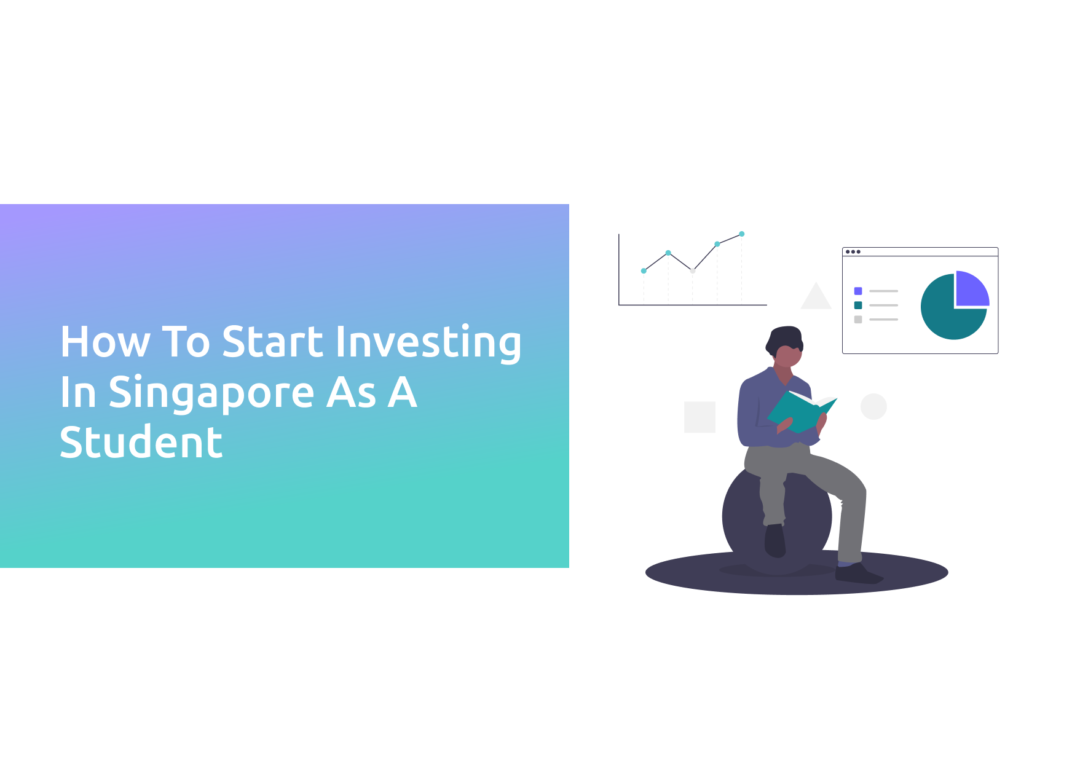Most of you would have heard about the importance of investing early and reaping the benefits of compound interest. However, the world of investing may be quite intimidating, especially if you’re a student or a teenager!
There may be quite a few terms that you are unfamiliar with.
If you have always wanted to start investing but have no clue on where to begin, let me share with you 12 key steps to help you get started:
Contents
- 1 How to start investing in Singapore as a student
- 2 #1: Ensure that you have an emergency fund
- 3 #2: Aim to reduce your debt
- 4 #3: Familiarise yourself with the different investment products
- 5 #4: Understand your risk profile
- 6 #5: Identify your investment goals
- 7 #6: Decide on the amount that you wish to invest
- 8 #7: Do your research on the available investment platforms
- 9 #8: Start small with regular savings plans or robo advisors
- 10 #9: Build your investment knowledge
- 11 #10: Consider buying individual stocks and ETFs
- 12 #11: Continue to fine-tune your investment strategy
- 13 #12: Be patient!
- 14 Conclusion
How to start investing in Singapore as a student
Here are 12 steps you can use to start your investing journey as a student in Singapore:
- Ensure that you have an emergency fund
- Aim to reduce your debt
- Familiarise yourself with the different investment products
- Understand your risk profile
- Identify your investment goals
- Decide on the amount you wish to invest
- Do your research on the available investment platforms
- Start small with regular savings plans or robo-advisors
- Build your investment knowledge
- Consider buying individual stocks and ETFs
- Continue to fine-tune your investment strategy
- Be patient!
#1: Ensure that you have an emergency fund
Before beginning your investment journey, it is extremely important to know your financial standing and ensure that you have a pool of emergency funds.
An emergency fund is essentially a safety net that you reach out for in times of emergency.
This allows you to have some money to fall back on, in the event that:
- Your investments do poorly
- You lose your job
Thus, having an emergency fund is an important step before you decide to start investing.
By investing all the cash you have, you may not have any left around in case of an emergency. You may not be able to pay for any unplanned expenses!
The recommended range of your emergency fund is between 3-6 months of your monthly expenses. However, there is no right or wrong answer on how much your emergency funds should have.
Ultimately, you should be choosing the amount that you’re most comfortable with!
Furthermore, while emergency funds should be liquid, your funds may lose their value due to inflation! Here are some places you can consider placing your emergency funds in.
#2: Aim to reduce your debt
As a student, especially in University, your main debt would likely be your student loan.
This can be a huge sum of money, especially when you do not have any income!
If you plan on investing, it is always ideal to find ways to reduce your debt. Look for ways to repay the amount you owe first.
If you can’t pay off your loan immediately, you can start by saving up a substantial amount that you can use to repay your debt.
Compound interest works both ways. Just as your investments can grow by compounding, so can your debt! If the interest rate of your debt is higher than your expected investment returns, it would be better to pay off your debt first.
If not, the amount that you owe the bank will slowly snowball into a really huge sum!
I, personally, have a student loan that I would have to pay off in the next 4 years.
Before I started investing, I made sure I had at least half of the amount I needed to pay for my student loan. This way, I knew I could at least have some additional lead time to earn the sum of my debt should my investments do poorly.
#3: Familiarise yourself with the different investment products
Whenever we plan on purchasing products that come with a hefty price tag (such as branded bags), we would most likely do some research before coming to a decision.
Some factors that you may consider include:
- Whether it belongs to the latest collections
- The material each bag is made out of
- The price each option that is available
This concept can be applied to investing too!
When it comes to investing, you would need to learn and familiarise yourself with the different investment products out there. From stocks to bonds and even Exchange Traded Funds (ETFs), different investment products offer varying returns and risk profiles. Some important questions to ask yourself include:
- What are the benefits, opportunities and risks of this product?
- Will buying this investment product incur any transaction costs?
- How will this investment product help me achieve my financial goals?
It is important not to invest in something that you are not sure about. You should do your own research first before purchasing any investment product.
This ensures that you’ll know exactly what you’re buying into!
Here’s a table of some of the key investment products you can start with.
Investments Product Comparison
| Investment Product | What it is | The Advantages | The Risks |
|---|---|---|---|
| Stocks | Ownership of a percentage of a company | Income from dividends. If the company does well, the returns are higher. | Price of stocks depends on macroeconomic factors. |
| Exchange Traded Funds (ETFs) | Basket of funds from different companies. | No need to actively manage your portfolio. Easy way to achieve diversification. | Price of stocks depends on macroeconomic factors. |
| Bonds | Governments / companies issue bonds to raise funds. | Stable and less volatile | Capital gains are not as high. |
| Real Estate Investment Trusts (REITs) | Basket of funds invested in a portfolio of real estate assets. | Better liquidity than investing directly in properties | Prices fluctuate with response to the demand and supply. |
| Cryptocurrency | Digital currencies that run on the blockchain network. | Thought to be the future of finance | Volatile and low correlation to fundamental economic factors |
#4: Understand your risk profile
No matter the product, there will always be risks when it comes to investing. Whether it’s systematic or unsystematic risks, it is crucial to understand how much risk you are willing to take.
This can be defined as how well you are able to stay the course if your investment portfolio suddenly drops by 20% overnight.
Would you sell or would you be able to continue holding?
Investing is all about risk management, and finding an appropriate level of risk you can handle.
Each investment product offers varying levels of risk:
1. Risk Averse
If you are risk averse, it is better to opt for safer investment products, such as bonds. Bonds are great for those who do not like taking risk since they are issued by governments and corporations when they want to raise money. Bonds are known to be less volatile and when held to maturity can offer more stable and consistent returns.
For example, you can create a 100% bond portfolio with Endowus. While the returns are lower than stocks, you still will earn a higher return compared to leaving your money in your bank account!
They are also known to be safer options as bondholders are likely to receive their initial investment back once the bond matures. When a company issues bonds to investors, it promises to pay back the money it borrowed plus any accrued interest.
2. Risk Neutral
If you are risk neutral, it may be a good idea to dabble in a portfolio consisting of:
- Cryptocurrencies
- ETFs
- Bonds
- Stocks
Buying into a range of asset classes helps you to reduce the negative impacts of market volatility. For example, the stock market may perform poorly during a certain time period.
However, you can rely on bonds that may do better in certain economic periods.
3. Risk Loving
If you love taking risks, invest in higher-risk products such as:
- Foreign exchange (Forex)
- Hedge funds
- Options
- Cryptocurrencies
These are indeed riskier, they may give you higher returns. However, the losses you incur will be higher too!
It is important to understand your risk profile before investing in any product. You won’t want to regret putting your money in an extremely risky product when you are someone who dislikes risks.
All of us have different levels of risk appetite. It is important to identify the amount that suits you best!
#5: Identify your investment goals
When you start your investment journey, it is critical to set goals beforehand. Knowing what you want to achieve from your investments will allow you to choose the appropriate strategies.
Ultimately, setting a goal will allow you to set form a strategy to achieve it.
Moreover, investment strategies are constantly subjected to change with different goals. It is not uncommon to have multiple financial goals at the same time.
However, you’ll need to be sure to get through each one step at a time!
Additionally, different goals have different time horizons. This would mean that you can take different amounts of risk for each goal.
Examples of Investment Goals
| Type of Goal | Time Horizon | Examples |
|---|---|---|
| Short Term Goal | < 5 years | Emergency funds Payments for cars Travel expenses |
| Long Term Goal | > 5 year | Retirement funds Paying off mortgage Future children’s school fees |
For example:
- If you have a short term goal, it may incur lower levels of risk (but not subjected to) as compared to a long term goal.
- For short term goals, you have a short time horizon. This means that you should invest in ‘safer’ options compared to stocks. These should give you lower, but more reliable returns.
- If you have long term goals (e.g. retirement plans) which have a longer time horizon, inflation is one risk they would need to consider. Inflation can subtly eat away investors’ purchasing power over time. Plus, you may not have the time to recover when you need the money for your goal.
You may be wanting to save up for your BTO that you intend to pay the downpayment in 5 years. Since you have a short runway, you would not want to place your funds into high risk assets like stocks.
If the market crashes just before you withdraw, you may receive less funds than you originally put in!
For these cases, the best way is to place your funds in something that has lower risks, but still gives you pretty decent returns.
This can include placing your funds in:
- Insurance savings plans
- Cash management accounts
- Bond portfolios of robo-advisors
The returns that you receive should help you to get better returns compared to leaving it in your bank account. If you leave your money with the banks, it’ll ultimately lose value due to inflation!
#6: Decide on the amount that you wish to invest
If you have always been hesitant on investing because you don’t have the extra funds to, here’s some good news: there’s no minimum to get started!
If you’re starting off with less than $1000, it is possible to buy one stock or ETF, and add more positions over time. You can even deposit your money in robo advisors, which help you do all the work.
Even though some stocks on the SGX have a low unit price, do keep a lookout for the minimum lot size on the SGX. For stocks, it is fixed at 100 units. However for ETFs, it can range between 5-100.
Usually, you can decide to invest a percentage of the salary that you receive. If you already have a sum of money put aside for your investments, you can use that too!
#7: Do your research on the available investment platforms
For each investment product, there are some investment platforms that you can use. Each comes with their own fees, and you should be familiar with all its features before you start to invest.
Let us go through some of the key terms you would come across when researching on platforms and brokerages:
- Minimum Fees
- These are the minimum fees that would be charged by the brokerage or platform.
- Commission Rate
- Commissions are the amount a brokerage or platform charges for performing the transaction.
- If your total trade value is $1000, and your commission is 0.08%, you will need to pay a commission of $0.80.
- Stock Holding Type
- There are two types of stock holdings: Custodian and CDP.
- A CDP account allows you to hold all purchased stocks under your name.
- A custodian account means your purchased stocks are held by the investment firms, meaning to say that you don’t own the stocks directly.
Here’s a table consisting of some of the most common ones to have on your radar.
Investment Platform Comparison
| Investment Platform | Commission Rate and Fees | Products Available | Stock Holding Type |
|---|---|---|---|
| Tiger Brokers | 0.08% (min. $2.88) | Stocks ETFs Mutual Funds Futures Options Warrants REITs | Custodian |
| FSM One | 0.08% (min. $8.80) | Stocks ETFs Retail Bonds Government Securities | Custodian |
| Saxo Markets | 0.06% (min. $5) | Forex Stocks Commodities Futures Crypto FX | Custodian |
| DBS Vickers | 0.25% (min. $25) | Stocks ETFs REITs | CDP |
| Interactive Brokers | 0.08% (min. $2.50) | Bonds Mutual Funds Futures Stocks Options | Custodian |
*The fees stated are for trading on SGX
#8: Start small with regular savings plans or robo advisors
If the brokerages above seem out of reach in terms of fees and commission rates, you can consider regular savings plans or robo-advisors instead!
These are a great way to start as the minimum investment amounts range from $1 to $100.
Here are some different platforms that you can use:
| RSP | Robo-advisor |
|---|---|
| OCBC BCIP | Syfe |
| DBS POSB Invest Saver | Endowus |
| FSMOne RSP | StashAway |
You can find out more about the differences between a robo-advisor and a regular savings plan here.
#9: Build your investment knowledge
While you are researching for the investment product to buy or an ideal brokerage, continue to grow your investment knowledge. It is important to understand that investing is a continuous learning journey.
Markets can be volatile, which is why learning about macro economic factors and various investment strategies are important.
The most basic principle you’ll need to understand is risks and rewards. Investments that are known to offer potentially higher profits are said to carry higher levels of risk.
On the other hand, investments that offer a potentially lower profit typically come with lesser risk. Knowing the basics is a must – but that’s not enough!
Try to do your own research on some investing strategies that you are most comfortable with, and are in line with your goals. Here are the three most common strategies that are available:
1. Buy and Hold
This strategy requires an investor to buy an investment product and hold it for a long period of time without selling it (yes, this could be decades).
You are buying into a stock or an ETF and are believing in its long-term growth. By buying and holding, you expect to receive a high return of investment when you eventually sell it.
The advantage of this strategy is that investors are not affected by short term price swings and market fluctuations. The goal here is to hold your assets for a long term!
2. Growth Investing
An investor that does growth investing would usually use fundamental analysis. This involves analysing financial statements and factors about the company. The goal is to find a firm who has the potential to grow in the years ahead.
Researching each company may be time-consuming and it may not be for everyone.
However, the it allows you to get a thorough understanding of the company you’re buying before making any decision.
That way, you are able to make much more informed decisions about the correct companies you should buy!
3. Dollar-cost averaging (DCA)
DCA is the practice of making regular investments over time. When you adopt a DCA strategy, you will deposit an amount into your account at interval periods. The advantage of this strategy is that you can start off with a small capital and slowly add more over a period of time.
Furthermore, you would also be able to capture prices at all levels, from high to low. This method then helps to lower the average cost per share of each purchase.
#10: Consider buying individual stocks and ETFs
Once you are more confident with investing, you may want to consider buying individual stocks and ETFs from brokerages.
These brokerages usually have a minimum fee and commission rates, which makes it cost inefficient to invest small sums that you would have as a student initially.
However, once you start working, you may have a larger sum available to invest. This makes it more cost effective for you to invest using a broker.
The minimum sum now forms a smaller percentage of your entire investment!
#11: Continue to fine-tune your investment strategy
Once you have started investing, it is always good practice to refine and tweak your investment strategy.
After investing for a while, you may realise that your strategy may need some improvements. Perhaps you may have chosen the wrong asset classes to invest in which does not fit your expected risks or returns!
There are tons of ways of finding out information, such as:
- Financial blogs
- YouTube videos
Gradually making changes to your investment strategy will allow you to monitor if your investments are able to help you reach your financial goals.
#12: Be patient!
Unlike day trading, investing is a long term strategy. You should not worry about short-term fluctuations. If you are investing, you believe that you are getting a high return over a long run.
On the other hand, trading would mean that you are looking to profit from short term price fluctuations.
Once you have parked your money in the investment product of your choice, leave it in for a few years. It is alright to check them from time to time, but don’t get too worried and anxious about small price fluctuations!
You’re in for the long run, so these fluctuations would not affect you when you see the bigger picture.
Conclusion
I hope this article has provided you with the necessary information you need to help you get started with investing as a student. It might seem overwhelming, but patience is key!
You should not rush into making investments. Instead, take your time to understand the steps and processes to ensure you’re on the right track.
You don’t have to park a huge sum of money when you first begin to invest – you can even invest with $100!
The main point is to start now and reap the benefits of compound interest overtime instead of letting your cash sit in your bank account.
Always look to improve your investment knowledge so that you can fine tune your strategy. It may not be the easiest when you’re starting out, but it’s definitely worthwhile!

Do you like the content on this blog?
To receive the latest updates, you can follow us on our Telegram channels (Personal Finance or Crypto) and Facebook.
Are you passionate about personal finance and want to earn some flexible income?





